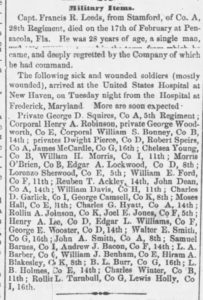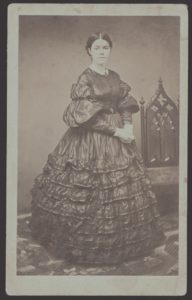This is a clip from the Hartford Courant of Friday 6 March 1863. Another great pile of information that I will need to go through, name by name. Eventually.
I’ve already found this useful for tracking at least two members of the 8th Connecticut Infantry wounded at Antietam on 17 September 1862 – Privates Hiram A. Blakeslee (Co. K) and Charles D Garlick (Co. I).
Galligans of Kalamazoo County, MI (c. 1862)
5 May 2024
25 year old 2nd Lieutenant George A Galligan, Company I, 17th Michigan Infantry was mortally wounded in combat at Fox’s Gap on South Mountain on the evening of 14 September 1862 and died 9 or 10 days later, probably in a field hospital in Middletown, MD.
Other than basic military service information, I’ve not found much about George after 1850, when he lived on his parent’s Michigan farm, except to find a pair of intriguing photographs accompanying his (above) in the Liljenquist Family Collection of Civil War Photographs at the Library of Congress:
The archivist has titled them, respectively, as Relative of Second Lieutenant George Galligan of Co. I, 17th Michigan Infantry Regiment, probably his wife and … probably his daughter. I’ve not been able to find their names.
If you look closely, you’ll see the carpet pattern is the same in all three photographs. The photographer is not identified for George’s portrait, but the mother and daughter’s pictures have the photographer on the back: E.A. Boughton’s Photograph Rooms, Kalamazoo, Michigan.
I’m guessing the freshly commissioned Lieutenant and his family had these taken together before he left Kalamazoo for war in August 1862.
Here’s Sergeant Lester Edwin Forrest Spofford after he lost his left arm to a wound and resulting amputation at Antietam on 17 September 1862.

You’d have thought that would have been enough of war for 18 year old Forrest, but it wasn’t. He was appointed Sergeant Major of the 8th Connecticut Infantry in January 1863 and he returned to serve with them to May of 1864, when he was wounded again. In the other arm.
After recovering from that wound he attempted to reenlist, but was turned away by a medical board and discharged at the end of his original term of enlistment on 20 September 1864.
This fine photograph is from the Buck Zaidel Collection, and was published in Military Images in Spring 2015 and featured in Longley & Zaidel’s Heroes for All Time: Connecticut Civil War Soldiers Tell Their Stories (2015).




